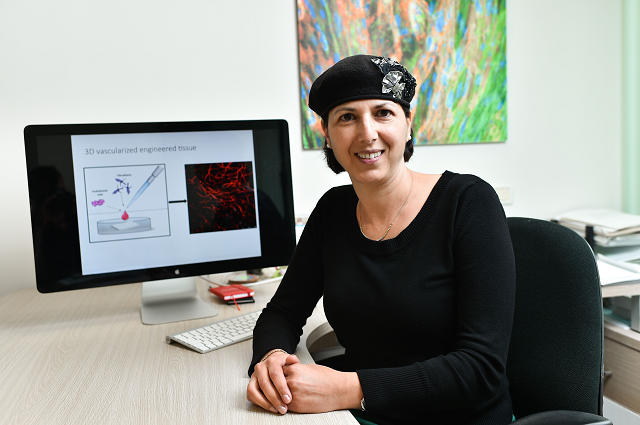Technion Scientists develop new technology for Bone and Soft Tissue Repair
The team created vascularized soft tissues for implantation using stem cells derived from the dental pulp, the soft tissue inside the tooth, together with capillary forming (endothelial) cells.

While it is possible to donate a kidney without risking one’s own life, people do not come with spare parts. Significant tissue loss can occur because of a variety of factors such as disease, injury, or infection, causing reconstructive surgery to repair the damage.
The autograft which involves removing tissue from one area of the patient’s body and transferring it to the injured area is currently the clinical “gold standard” in reconstructive surgery. For example, to rebuild the lower jaw, surgeons may take a piece of the patient’s fibula bone, as well as the soft tissue and blood vessels that surround it, from the patient’s leg. For the bone to survive in its new position, soft tissue and blood vessels are required.
Of course, removing a large portion of one’s body has significant drawbacks, such as significant discomfort or any of the usual complications associated with donor site surgery. As a result, scientists are looking into tissue engineering as a potential replacement for tissue harvesting.
While some progress has been made in this field, there are still major challenges to overcome in the search for tissue replacements, one of which is de novo tissue generation. Fresh tissues would be grown in a lab rather than transplanted from one part of the body to another.
Prof. Shulamit Levenberg and her colleagues from the Faculty of Biomedical Engineering at the Technion-Israel Institute of Technology will assist. Her tissue regeneration lab has been studying the formation of complex blood vessel networks in lab-grown tissues.

Her team recently built soft tissues with blood vessels for implantation using stem cells from the dental pulp – the soft tissue inside the tooth – and capillary-forming endothelial cells. The addition of dental pulp stem cells aided blood vessel formation, resulting in improved tissue remodeling and repair. Using these methods, her team was able to aid spinal cord regeneration in rats. The title of their paper, “Engineered Vascularized Flaps, Composed of Polymeric Soft Tissue and Live Bone, Repair Complex Tibial Defects,” published in the journal Advanced Healthcare Materials.
In Levenberg’s lab, Dr. Idan Redenski and his colleagues were able to resolve the challenge of implanting bone in reconstructive surgery so that it would be protected by soft tissues and fed by blood vessels. The team combined their own vascularized tissue technology with biological bone implants developed at Columbia University by Prof. Gordana Vunjak-Novakovic to create a de novo tissue flap containing live bone assisted by vascularized soft tissue. The concept of implantable bone tissue was raised to new heights as a result of this.
After demonstrating that a mixed tissue flap can be grown, the team used the new technique to repair a bone defect in rats in a two-step procedure. A soft tissue flap was first created and inserted. After being inserted into the rat’s body and used to repair a bone defect while being covered by large blood vessels near the defect site, the engineered flap was exposed in a second procedure.
While the decellularized bone was covered by the engineered tissue flap, it was exposed and inserted to correct the defect. The treatment worked well, with the soft tissue assisting and feeding the bone, bridging the bony defect, and the rat’s cells growing in and replenishing the implant. It was essentially a complete recovery, much superior to everything reconstructive surgery could do and not reliant on the patient’s own tissue.
Levenberg, Redenski, and their colleagues hope that one day, a patient will be able to receive a lab-grown bone that precisely fits the shape of his face, surrounded by lab-grown soft tissues made from their own cells cultivated on three-dimensional biomaterials. There will be no need to harm the patient’s other organs.
Redenski is about to begin an oral and maxillofacial surgery residency at Galilee Medical Centre, where he plans to continue his studies and put the methods he studied in Levenberg’s lab into effect.
Read more about: bone implants, Technion – Israel Institute of Technology



